The Water-Energy Nexus: Oil and Gas
Water, Land, and Environment in energy exploration and production: studies related to hydraulic fracturing, water, and the environment.
CURRENT PROJECTS
J.-P. Nicot, PI: Assessment of Brackish Water Use for Hydraulic Fracturing: Case Study Eagle Ford Shale Play
J.-P. Nicot, PI: Nature of flowback: Water shale interactions at high temperature and pressure
J.-P. Nicot, PI: Stray gas in unconventionals–pressure
REPORTS and PUBLICATIONS
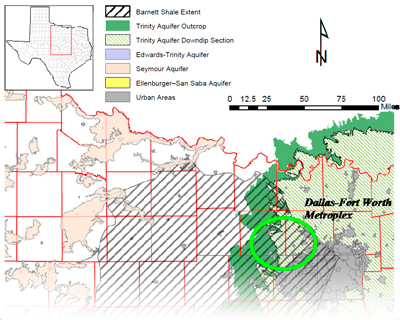
“Assessment of Industry Water-Use in the Barnett Shale Gas Play, (Fort Worth Basin, 2006), 2009
J.-P. Nicot
[download PDF]
This paper summarizes the results of a TexasWater Development Board-funded study designed to estimate water use associated with hydraulic fracturing throughout the life of the Barnett Shale play in North Texas. Over 10,000 gas wells currently exist in the play, with thousands more likely to be drilled over the next two decades. A typical vertical well consumes approximately 1.2 million gallons (Mgal) of fresh water in its completion, while a horizontal well generally consumes 3.0-3.5 Mgal. Total water use throughout the life of the play is highly uncertain and will be primarily impacted by the price of gas. Projections for a high water use scenario estimate that 417,000 acre-ft will be used between years 2007-2025, resulting in an average annual use of 22,000 acre-ft.
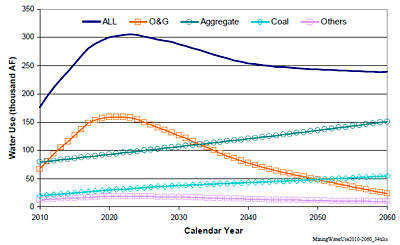
“Current and Projected Water Use in the Texas Mining and Oil and Gas Industry, June, 2011
J.-P. Nicot
[download PDF]
This study was prompted in 2009 by the sudden increase in statewide shale-gas production and was designed to help in the next cycle of water planning by the Texas Water Development Board. The objective of the study was to quantify current and projected future water use associated with the mining industry in Texas (oil and gas, coal, aggregates, and other mineral industries). The approach of the study was to contact actual mining facilities and to interview experts in relevant mining fields to inform future projections. Results indicated that in 2008, the mining industry used approximately 160,000 acre-ft (AF) of water including about 36,000 AF for hydraulic fracturing of oil and gas wells. Water use by the mining industry was projected to peak in the 2020s at slightly above 300,000 AF per year, then to slowly decline until the year 2060. Water use projections were also presented at the county level across the entire state. This study was supplemented by a 2012 update that distinguished between water use and water consumption, and that incorporated a large shift from gas to oil production in the oil and gas industry.
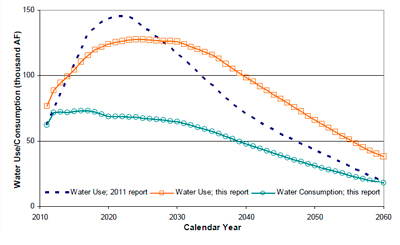
Oil and Gas Water Use in Texas: Update to the 2011 Mining Water Use, May, 2012
J.-P. Nicot
[download PDF]
This work represents an update (as of Spring 2012) to the hydraulic fracturing sections of the 2011 report titled “Current and Projected Water Use in the Mining and Oil and Gas Industry.” The update was prompted by: (1) a major shift in the oil and gas industry from gas to oil production, displacing production centers across the state, and (2) rapid technological advances, resulting in more common reuse of water and in increased ability to use brackish water. This update clearly distinguishes between water use and water consumption, providing county-level estimates of these values as well as future projections to the year 2060. Overall, water reuse and brackish water use was found to have increased alongside total water use, as hydraulic fracturing has expanded into the drier southern and western parts of Texas. The updated projections at the state level did not show a major departure from the original report, with peak water use plateauing near 125,000 acre feet per year (AF/yr) during the 2020’s, while fresh water consumption was projected to stay near the current level of roughly 70,000 AF/yr for several years and decrease in future decades. These values remain small compared to the state water use, although hydraulic fracturing may represent a higher percentage of total water use in some local areas.
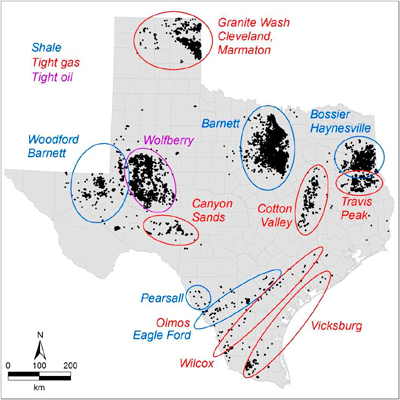
Water Use for Shale-Gas Production in Texas, U.S.
J.-P. Nicot, Bridget Scanlon
[download PDF]
The objective of this study was to quantify net water use for shale-gas production throughout Texas with a focus on three plays: The Barnett Shale, the Texas-Haynesville Shale, and the Eagle Ford Shale. Past water use was estimated from existing well-completion data, and future water use was extrapolated from past water use constrained by shale-gas resources. Cumulative water use in the Barnett totaled 145 million cubic meters (Mm3) and represented roughly 9% of annual water use in Dallas. Water use was less in Eagle Ford plays but is increasing rapidly. Cumulative water use over the next 50 years in all Texas shale plays total approximately 4,350 Mm3. Annual water use is projected to peak near 145 Mm3 per year in the mid-2020s, and decreasing to 23 Mm3 in 2060. Current freshwater use for hydraulic fracturing may shift to brackish water to reduce competition with other users.
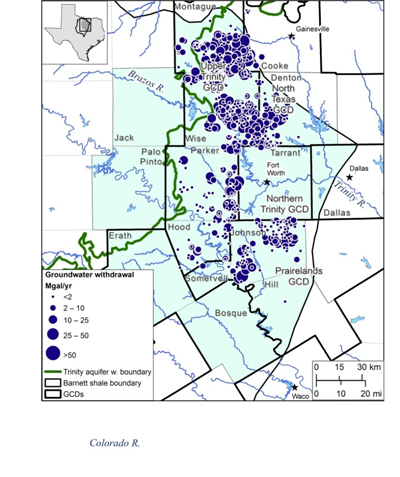
Source and Fate of Hydraulic Fracturing Water in the Barnett Shale: A Historical Perspective
J.-P. Nicot, Bridget Scanlon, Bob. Reedy, and Ruth Costley
[download PDF]
Considerable controversy continues about water availability for and potential impacts of hydraulic fracturing (HF) of hydrocarbon assets on water resources. Our objective was to quantify HF water volume in terms of source, reuse, and disposal, using the Barnett Shale in Texas as a case study. Data were obtained from commercial and state databases, river authorities, groundwater conservation districts, and operators. Cumulative water use from ~18,000 (mostly horizontal) wells since 1981 through 2012 totaled ~170 thousand AF (kAF–210 Mm3); 26 kAF (32 Mm3) in 2011, representing 32% of Texas HF water use and ~0.2% of 2011 state water consumption. Increase in water use per well by 60% (from 3 to 5 Mgal/well; 0.011–0.019 Mm3) since the mid-2000s reflects the near-doubling of horizontal-well lengths (2000–3800 ft), offset by a reduction in water-use intensity by 40% (2000–1200 gal/ft; 2.5–1.5 m3/m). Water sources include fresh surface water and groundwater in approximately equal amounts. Produced water amount is inversely related to gas production, exceeds HF water volume, and is mostly disposed in injection wells. Understanding the historical evolution of water use in the longest-producing shale play is invaluable for assessing its water footprint for energy production.